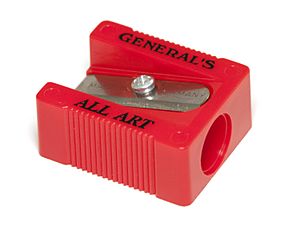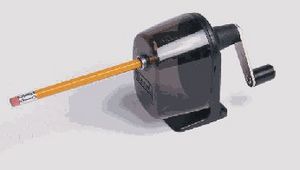Pencil sharpener facts for kids
A pencil sharpener (also referred to as pencil pointer or in Ireland as a parer or topper) is a tool for sharpening a pencil's writing point by shaving away its worn surface. Pencil sharpeners may be operated manually or by an electric motor. It is common for many sharpeners to have a casing around them, which can be removed for emptying the pencil shavings debris into a trash bin.
Contents
Manual sharpeners
Prism sharpeners
So-called "prism" sharpeners, also called "manual" or "pocket" sharpeners in the United States, have no separate moving parts and are typically the smallest and cheapest commonly used pencil sharpener on the market. The simplest common variety is a small rectangular prism or block, only about 1 × 5/8 × 7/16 inch (2.5 × 1.7 × 1.1 cm) in size. The block-shaped sharpener consists of a combined point-shaping cone that is aligned to the cylindrical pencil alignment guide hole, into which the pencil is inserted. A sharp blade is mounted so that its sharp edge just enters the shaping cone tangentially. The pencil is inserted into the sharpener and rotated while the sharpener is held motionless. The body of the sharpener is often contoured, ridged or grooved to make the small block easier to firmly grip, and is typically made of aluminum alloy, magnesium alloy or hard plastic.
The blade inside the sharpener shaves the wood and graphite tip of the pencil, while the shavings emerge through a slot along the blade edge. It is important that the cylindrical alignment hole closely fit the diameter of the pencil, to keep the pencil from wobbling, which would cause stepped or lurching cut-depths and point breakage. Another important feature is a larger clearance hole at the end of the cone allowing sections of the pencil lead which break away to be removed with only minor inconvenience. Prism sharpeners can be bare or enclosed in a container to collect the shavings, while some enclosed sharpeners may be harder to clear in the event of a blockage.
A few prism sharpeners are hand-cranked, rotating the cutting blade instead of rotating the pencil. Moderate care is needed to not break the tip of the pencil being sharpened, requiring the pencil to be sharpened again. However, because pencils may have different standard diameters in different nations, imported sharpeners may have non-standard-sized alignment guide-holes, making sharpening attempts difficult. If the alignment hole is too small, the pencil cannot be inserted, while if it is too large, the tip of the pencil repeatedly will break off. Prism sharpeners may be right- or left-handed, requiring clockwise or counter-clockwise rotation of the pencil being sharpened.
Linear blade sharpeners

Unlike prism sharpeners, linear blade sharpeners do not rotate relative to the pencil being sharpened, and may be viewed as just a special form of knife, with a mechanical guide for increased safety and convenience. Some models use replaceable shaving razor blades, while others have permanently-fitted blades. Linear blade sharpeners may require more skill, but they allow one to sharpen the tip of the pencil into any desired shape and angle of taper, whereas prism sharpeners have a fixed sharpening angle and produce circular symmetry.
While most linear blade sharpeners are simple and directly hand operated, some devices in the past were crank operated, using mechanisms to convert crank rotation into linear motion.
Cylindrical (planetary) sharpeners
These mechanisms are also called planetary sharpeners, in reference to their use of planetary gears. A larger, stationary planetary sharpener can be mounted on a desk or wall and powered by a hand crank. Typically, the pencil is inserted into the sharpener with one hand, and the crank is turned with the other. This rotates a set of helical cylindrical cutters in the mechanism, set at an acute angle to each other. The multiple cutting edges quickly sharpen the pencil, with a more precise finish than a single-blade device. Some cylindrical sharpeners have only one helical cutter cylinder, but most have two cylinders or more.
Most planetary sharpeners have a large opening, with a rotatable guide disk in front of it that has multiple holes of different sizes, to accommodate pencils of many different diameters. Advanced models have a spring-driven holder for the pencil, so that the pencil automatically is pushed into the mechanism while being sharpened. Some versions also offer a regulator of the desired sharpness, since it is not always desired to make the graphite core needle-sharp.
Other systems
Some older models like the 1897 German Jupiter 1 used reversible rotary cutter-disks with cutting edges radiating from the center on each side. These were high-end models, quite large and expensive. Others simply used abrasives like sandpaper. In some cases an abrasive was used to shape the graphite core, while the wood was cut some other way.
Electric sharpeners
Electric pencil sharpeners were introduced by 1940. They work on the same principle as manual ones, but one or more flat-bladed or cylindrical cutters are rotated by an electric motor. Some electric pencil sharpeners are powered by batteries rather than being plugged into a building's electrical system, making them more portable.
Auto-stop electric pencil sharpeners are able to sense when the tip of the pencil is long enough, so they stop automatically. In basic automatic pencil sharpeners, the lead may become too long and break, and so users must be careful to supervise the operation.
Razor knife
Artists and craftsmen may use a very sharp knife to sharpen pencils and other media freehand, without the use of any mechanical guides. For example, the tip may be cut into a triangle shape, and then the edges of the triangle are trimmed down. This technique requires a total of 6 cuts, and takes practice to master without breaking the lead.
Specialized pencil sharpeners
Specialized sharpeners are available that operate on non-standard sizes of pencil-shaped markers, such as wax crayons used in primary schools. Sharpeners that have two openings, one for normal pencils and one for larger crayons, are fairly common. Sharpeners with a single blade for use on wax crayons are available, and sometimes included in boxes of crayons. These often have plastic blades, which are adequate for the soft wax.
An artist's or draftsman's pencil sharpener leaves the graphite untouched and sharpens only the wood (some models can switch from standard to wood-only by an adjustment). The graphite lead is then honed to a sharp point with a lead pointer, which sharpens only the lead without wood. Lead pointers are also used with mechanical lead holders, which have removable/refillable leads. Some sharpeners which function as a long point sharpener, have a second hole in which the blade sharpens the untouched graphite to a long, more precise point than would be otherwise possible using a single hole long point sharpener.
Carpenters may use carpenter pencils, the flattened shape of which stops them from rolling away, while still providing a constant line width. These pencils were traditionally sharpened with tools conveniently to hand, such as a plane or sandpaper. Rotating pencil sharpeners are now available for these, in which a rotating plastic collar holds the pencil in position, although they then sharpen them to the usual conical point as for a round pencil, abandoning some distinctive aspects of the carpenter's pencil.
Mechanical pencils dispense the graphite lead progressively during use and thus do not require sharpening; such pencils are sometimes called "self-sharpening". A type of mechanical pencil has a rotating gear mechanism which rotates the lead slightly every time the lead is lifted off the paper, helping to maintain a consistent, sharp point. If a finer or broader line is needed, a separate mechanical pencil using a lead with a different diameter is required.
Pencil Sharpener Gallery
Images for kids
-
Ecologically manufactured pencil sharpener made of wood
See also
 In Spanish: Sacapuntas para niños
In Spanish: Sacapuntas para niños

















